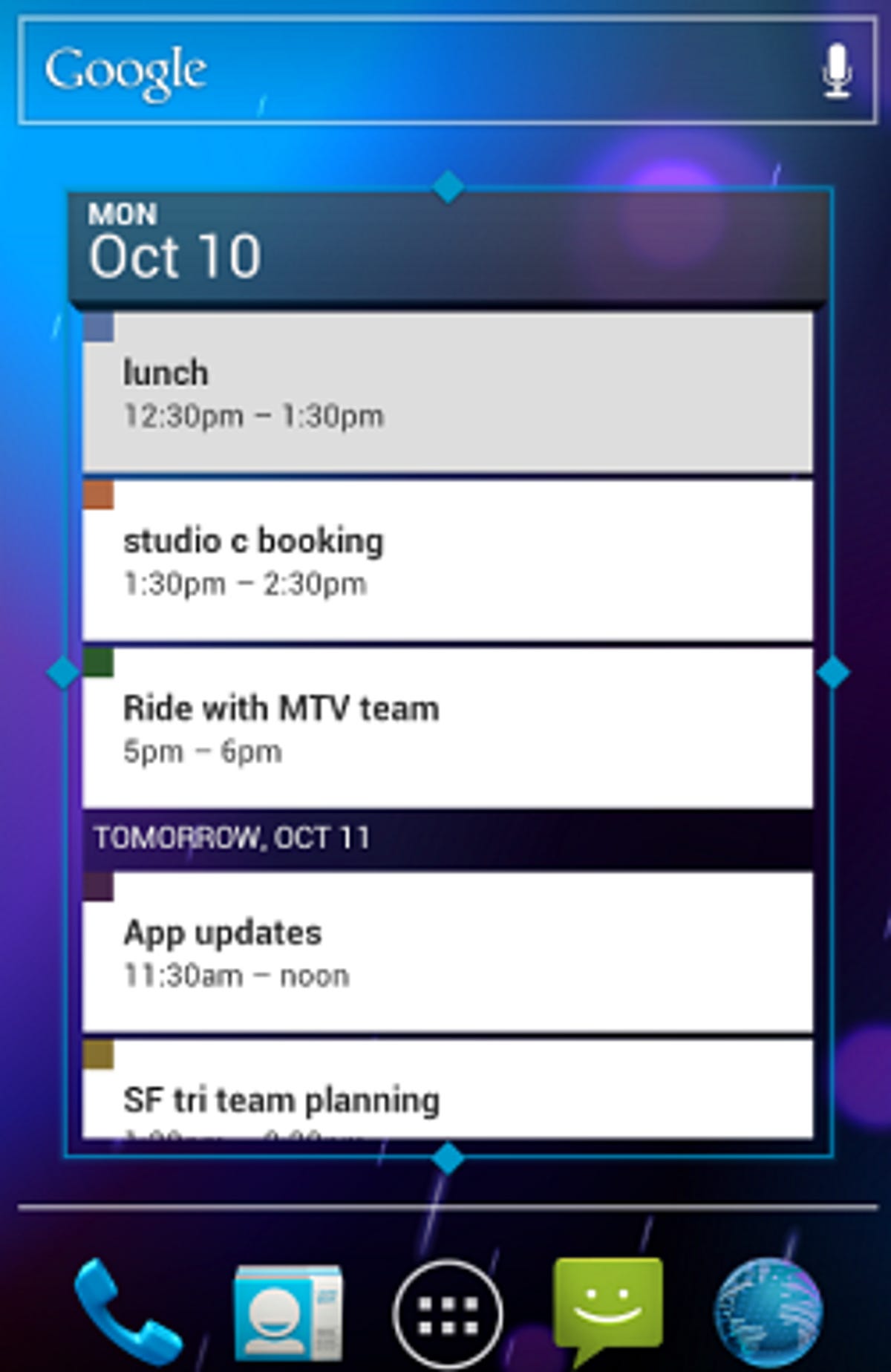The big, robust Android 4.0 Ice Cream Sandwich OS that Google announced in Hong Kong last night makes Android 2.3 Gingerbread look like an old, stale cookie.
We first heard about Ice Cream Sandwich back in May at Google I/O, and even though there have been feature leaks leading up the big unveiling, there was a lot we didn’t see coming.
Ice Cream Sandwich is packed with weird and wonderful new features, a dramatically changed interface and fonts, and improved camera software, plus tons more. We won’t be able to get to every feature here, but we will cover the big stuff.
Operating systems unite!
One of the very first clues we had from Google was that Ice Cream Sandwich would combine the best of Honeycomb 3.0 for Android tablets and the Android Gingerbread 2.3 OS to create a single, united operating system that developers would use for all Android devices going forward. We were promised Honeycomb’s “holographic” user interface, more multitasking, a new apps launcher, and richer, resizable widgets. And, for the most part, we got them.
A unified operating system has a serious and direct effect on Ice Cream Sandwich’s interface, and on fragmentation. We’ll dive deeper into both below, but let’s just get one thing out of the way and say this single OS for all Android devices is a very good thing. Honeycomb was a valuable one-off tablet learning experience for Google, but we couldn’t get back to a single environment soon enough.
Related stories:
Ice Cream Sandwich to follow Galaxy Nexus release
Samsung Galaxy Nexus first impressions: Ice Cream Sandwich makes it sparkle
Android identity crisis: Is it for nerds or everyone?
New OS, new look
What hasn’t changed about Ice Cream Sandwich’s look and feel? Without exactly saying so, Google is heralding a completely new Android identity, one that waves goodbye to its cutesy-friendly stock Android persona in favor of Honeycomb’s darker color, blockier lines, and boldness.
In fact, as we learned more about the brand-new interface, the Honeycomb influences were evident. Gone are the physical hardware buttons; Ice Cream Sandwich prefers to use touch-screen controls instead, similar to Honeycomb. (Hardware makers will still have options.) This will allow the interface to take up a greater portion of the phone’s face, if not its entirety. The flick-through method of seeing your open and recently used programs is also taken directly from Honeycomb.
It isn’t just the strong lines, full-screen images, and deliberate use of color that make this a much more grown-up Android. Google is also scrapping the old font in favor of a new one called Roboto. It’s designed to render crisply, making text even easier to read. We’ll have to reserve our judgment for the real thing in our hands, but we’re all for improved readability.
Unwrapping Android Ice Cream Sandwich 4.0 (photos)






The new look shows up everywhere. There’s a new, great-looking lock screen, with its glowing central circle you drag to unlock, and the ability to open a select app the second you unlock the phone (so very like the HTC Sense 3.0 custom Android UI).
There’s the “magazine-style” grid of thumbnails that appears in various places, like viewing your browser bookmarks. The way that your contacts are organized in various “cards” is familiar, and also uses the same strong design elements of thick bold bars and a full-size photo in the background. When you dial a friend, you’ll see your friend’s image take up a large portion of the screen as well. The tiles and calling elements in particular scream “Windows Phone.”
Until we see Ice Cream Sandwich in front of us, we can’t be certain how well all the elements will go together.
Gesture support
Navigation buttons may be a thing of the past on some phones, but Android 4.0 replaces them with gestures like swiping (a WebOS borrow) and pinch and zoom. We love the idea of swiping stuff away to close or delete items, and pinching and zooming not just to zoom in, but to view more detail about your phone’s functions. Turns out, Google wants you to give its phones the finger.


Widgets ‘n’ folders
Resizable widgets are a reality for all Android 4.0 phones, not just the Samsung Galaxy S II phones (you shrink and expand widgets by moving them at the corners). The entire widget experience is new to smartphones, and that kind of flexibility is never a bad thing. In addition, Ice Cream Sandwich lets you group apps into home screen folders by dragging and dropping icons onto each other. We liked it with iOS 4, and we like it here, too.
Calendar zoom
The most interesting new thing here is that you can swipe through months, days, and weeks, and pinch your fingers to see more granularity. For example, pinch to switch from the day to the hour.
Copy/paste, screenshots
A very slight change can also be a good one. After selecting text in Ice Cream Sandwich, you can drag it and drop it elsewhere, which should be faster and more natural than just using the designated onscreen controls. The ability to natively take screenshots has also been a long (looong) time coming, and is a boon for us journalist types who rely on screenshots in our daily work. However, they’re useful for anyone. You’ll just press on the volume button while also pressing the power button. If you like that, you can thank Apple for the idea.
Camera goodies galore
The bulk of the new OS features come to the camera, and we have to say, it’s about time. Yes, the camera, like every app we saw featured, gets a slightly new look. What excites us most are the editing tools built into the Gallery app. Yes, there are third-party apps galore to remove red-eye, crop, straighten, and apply “hipster filters” (do they dress your subject in skinny jeans?!), but we’d rather have those options baked right into the operating system.
The camera also has the much-buzzed-about panorama mode, and facial detection that assists with focus. There’s plenty more, too, which we’ll explore with a phone in hand.
Visual voice mail for the win
Google jumped into the visual voice mail feet first when it bought GrandCentral in 2007 and turned the property into Google Voice. Since then, Google has had plenty of experience handling comically imperfect voice transcriptions. In Ice Cream Sandwich, voice transcriptions from your voice mail provider (not necessarily Google Voice) already show up by default in your list of missed calls. If someone’s being especially long-winded, you can slice through the verbose voice mail by fast-forwarding. Bravo, we say; the more integration, the better.
Tap-to-pay with NFC and Google Wallet
The Galaxy Nexus follows the Nexus S in its onboard NFC chip, and adds Google Mobile Wallet, which lets you tap the phone to a payment terminal to pay for goods. If you’ve got a MasterCard, you’re already good to go.
Beam me up, Scotty
Android Beam is an innovative use of NFC technology that lets you share information simply by tapping two phones together. Similar to BlackBerry Tag, you can use Android Beam to share links, contacts, and map locations. There are other apps, such as Bump, that perform similar tasks, but are not based on NFC. Android Beam also lets you share apps–somewhat. When you tap the phones together, the recipient will be directed to the Android Market where he or she can download the intended application.


Facial unlocking
Back at Google I/O, the Android team showed off an OpenGL feature-tracking system that Google demoed with a camera app that followed and automatically focused on the speaker walking around the stage. We didn’t see a direct correlation in Ice Cream Sandwich, but in the same vein is the wacky facial unlocking feature, which lets you (optionally) peer into the front-facing camera to unlock your phone.
In theory, it recognizes your face alone, but in the demo, it even rejected the phone owner (he claimed it was a result of too much stage makeup). That’s never a good sign, and there are enough “if” and “maybe” scenarios when it comes to its limitations that right now we’re viewing it as a cool, fun idea that has little practical purpose. Still, even without seeing it in person, we’ve got to give Google a thumbs-up for trying.
Fragmentation: It’s not over yet
At Google I/O, Google acknowledged the problem of fragmentation head-on. It promised a set of new APIs that will help developers optimize apps for different devices, and more importantly, it is encouraging all its partners to run the latest version of Android for at least the first 18 months of new product releases. It’s unclear how the company hopes to implement that, but at least that’s the goal.
Even if the OS systems are aligned, there are still the skins to think about. Part of the reason carriers may be slow to update a phone to the newest OS is because of all the back-end work required to make the OS play nice with a manufacturer’s custom skin or interface. Why they do it: to set themselves apart from the competition. Ice Cream Sandwich doesn’t necessarily get rid of that possibility. As we mentioned above, the look and feel of Ice Cream Sandwich are a massive departure from previous firmware updates, and not everyone will like it. You might still see HTC implement Sense or Motorola stick with Motoblur, if only to please the few dissatisfied Android users who aren’t big fans of pure Ice Cream Sandwich.
Haven’t we seen this before?
It’s said that imitation is the highest form of flattery, but at times it’s also a business necessity. We pointed out when Apple borrowed from rival OSes in iOS 5, and Android 4.0 is no different. From iOS, it takes screenshots and folders. From Windows Phone, it takes many design elements, like the People and dialing setup in particular. From WebOS, there are the flicking-away gesture and the communication between two devices in the same ecosystem. The ability to drag the lock screen button over icons to open an app from the locked position comes directly from HTC Sense 3.0.
We’re not necessarily saying it’s a bad thing–this kind of building-on-the-shoulders-of-giants happens all the time–but it’s always a good idea to trace the influences lest we give the Android engineers credit for some other company’s first-to-market effort.
So what do we think?
Wow. It’s a big, huge update, and there’s much that’s still unexplored. We’ll leave you to digest the details and return when we’ve got Ice Cream Sandwich on our plates. What do you think–are you excited about the release, or are there elements you question?
Editors’ note: This article was originally published May 10, 2011, after the Google I/O announcement of Ice Cream Sandwich, and updated October 19, 2011, after the official Android 4.0 launch.



